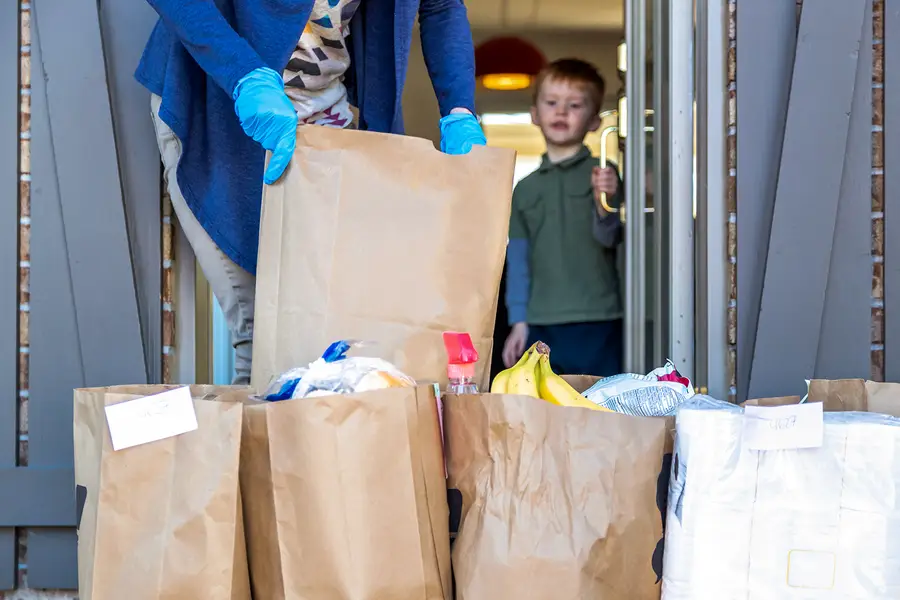Insights
Will Online Grocery Shopping Benefit SNAP Participants?

A plan to include online shopping as a benefit for SNAP recipients has picked up speed because of the COVID-19 pandemic.
The onset of the COVID-19 pandemic has made us all aware that our food system is sensitive to unanticipated shocks. Images in the media of empty supermarket shelves and stories about COVID-19 outbreaks in meat processing facilities raise concerns about our ability to access the foods we need to feed our families. As with most crises, those who are already vulnerable are also those who are least able to adapt to changing social conditions. When it comes to having enough food in the United States, households in the Supplemental Nutrition Assistance Program (SNAP) are among the most vulnerable. SNAP is a hunger safety net program administered by the U.S. Department of Agriculture’s (USDA’s) Food and Nutrition Service. Its goal is to reduce food insecurity. SNAP achieves this goal by providing lower income households with financial resources on a monthly basis that fill in the shortfall between the amount of money they have to buy food (considered to be 30 percent of household income) and the amount they need to ensure that everyone can eat a nutritionally sufficient diet.
USDA announces pilot program for SNAP participants to use online shopping platforms
To address pandemic-related concerns about access to foods among vulnerable households, USDA recently announced that it is accelerating a program designed to allow Americans participating in SNAP to use online grocery shopping platforms to pay for food purchases using their SNAP benefits. The 2014 Farm Bill authorized USDA to conduct and evaluate a pilot that was intended to ensure online transactions can be processed safely and securely. In April 2019, USDA announced that SNAP participants will be able to select and pay for their groceries online in New York State. Washington State followed in January 2020, and in early March, Alabama, Iowa, and Oregon also launched SNAP online purchasing pilots. As a result of the pandemic, 37 states have been approved to participate in the program.
Ostensibly, use of online shopping will provide lower income households with greater access to food and the same kind of flexibility that non-SNAP households currently enjoy. But how will online grocery shopping benefit lower income SNAP participants?
How will SNAP participants take part in online grocery shopping?
When the Online Purchasing Program was announced, then Secretary of Agriculture Tom Vilsack claimed that “Online purchasing is a potential lifeline for SNAP participants living in urban neighborhoods and rural communities where access to healthy food choices can be limited.” This comment reflects the tendency for us to think about home delivery as the default option when we think about online grocery shopping. Shoppers go to a website, click a few links, and bags of food are dropped off at their doorstep. Home delivery is one option, but it is not the most common form of online grocery shopping in the United States nor is it the form that’s going to be most accessible to SNAP participants. For one thing, SNAP participants who want fresh and healthy groceries delivered to their homes must live within a reasonable distance to an authorized SNAP retailer. As of now, that means either a Walmart (as of this writing, only if you live in New York State) or an Amazon distribution center. In most states, these are the only two retailers that have been approved for home delivery in the SNAP program. Of course, shoppers can get a box of cereal or mac-n-cheese delivered no matter where they live, but perishables like milk and fruits are not readily available. For another thing, home delivery can include added expenses that SNAP participants cannot cover using their SNAP benefits. Delivery charges at Amazon are applied to orders below $35, and charges at Walmart range from $7.95 to $9.95, or you can sign up for unlimited delivery at $12.95 a month or $98 annually. To put that into context, the 2020 Thrifty Food Plan estimates that it costs $37.50 a week to feed a 9- to 11-year-old child. So, that $12.95 monthly fee (which might sound like a good deal) would feed a 10-year-old child for 2 and ½ days.
In contrast to home delivery, “click-and-collect” online shopping is more common and more likely to be the mode that SNAP participants use. This is where the real action in online SNAP purchasing will likely play out. Click-and-collect shopping basically means that someone who works for the retailer acts as a personal shopper. The customer creates a grocery list online, sends it to a local SNAP-approved retailer, and a store employee runs up and down the aisles collecting food. The customer then drives to a designated parking space where the food items are brought to the car. Another wrinkle is that most local SNAP-approved retailers have not been approved to accept SNAP benefits online. To prevent fraud, SNAP benefit redemption requires the use of a PIN, and, at the time of this writing, only one company in the United States is authorized to develop secure PIN systems that would allow SNAP participants to pay online. For now, at least, the majority of SNAP shoppers must go into the store and swipe their benefit card to pay for their groceries.
Will SNAP participants want to shop online for groceries?
Online grocery shopping in the United States has increased in the wake of the COVID-19 pandemic, but not as much as one might think. One year ago, Gallup reported that a little less than 2 in 10 Americans (19%) had ever ordered groceries online. Data collected at the onset of the pandemic (March 2020) found that 3 in 10 households (31%) reported having done at least some of their grocery shopping online—using either home delivery or click-and-collect—in the past 30 days. In other words, the vast majority of American households are still doing all or most of their grocery shopping in brick-and-mortar stores.
Although there is as yet no data on online shopping among SNAP participants, two studies involving lower income families in the SNAP program, one conducted in 2013 and the other conducted in 2019, suggest that participants are not very likely to see much of a benefit from access to online shopping. In both studies, online shopping was used infrequently and only by a small subset of the study participants. Those who used online shopping reported concerns about food quality and freshness and a lack of control over the selection process. They also tended to spend more of their SNAP benefits on sweets and salty snacks when shopping online compared with their out-of-pocket spending. The study conducted in 2019 found that prices for online products were significantly higher than prices in brick-and-mortar stores, mostly due to in-store discounts and specials offered.
So, what’s next?
The COVID-19 pandemic created chaos in the retail food sector and heightened consumer anxiety about the availability of food. The decision to push the SNAP online purchasing pilot was clearly well intentioned. Some SNAP participants will want to shop online. Click-and-collect may save SNAP participants time and may particularly benefit seniors and parents who lack childcare options. Of course, convenience costs (i.e., both delivery fees and charges for click-and-collect shopping) will have to be weighed carefully by families with limited resources. For others, online shopping may limit time spent in brick-and-mortar supermarkets, enhancing their ability to social distance. However, as Erin Bromage, Associate Professor of biology at the University of Massachusetts–Dartmouth explains, “the low density, high air volume of the store, along with the restricted time you spend in the store, means that the opportunity to receive an infectious dose [of COVID-19] is low.”
There is a clear need for more evaluation and publicly available information about the SNAP Online Purchasing Program. The program, as it is currently available to SNAP participants, is not necessarily the bridge to healthy fresh foods that many envision. As states roll out online SNAP purchasing programs in response to the COVID-19 crisis, we should pay attention to who benefits from these programs. Rural, lower income families and those in urban areas that lack supermarkets may be unintentionally excluded, exacerbating food availability-related inequities. Because online marketing allows for an incredible degree of tailored promotion, retailers may attempt to promote higher profit, less healthy choices to lower income households. We should also follow SNAP online purchasing patterns to see if participants who begin online shopping because of the pandemic continue to use this option as concerns about the virus and social distancing subside. On the retail side, it is worth looking at the effect of channeling SNAP dollars away from smaller and locally owned business and toward two of the largest retailers in the country. Increasing choice through access and availability is a laudable policy goal but only if the policy improves the lives of the people it is designed to benefit.
Disclaimer: This piece was written by Jonathan Blitstein (Public Health Psychologist), Kristen C. Giombi (Research Economist), and Mary K. Muth (Director, Food Economics and Policy) to share perspectives on a topic of interest. Expression of opinions within are those of the author or authors.


